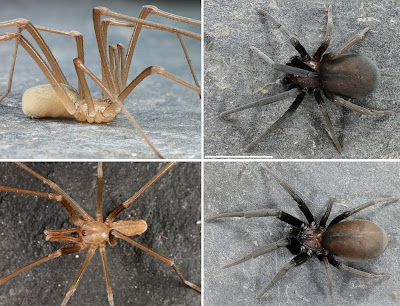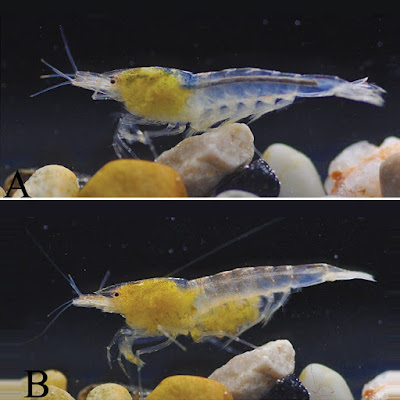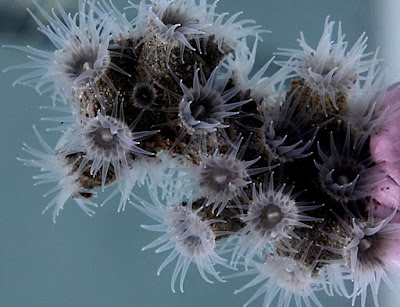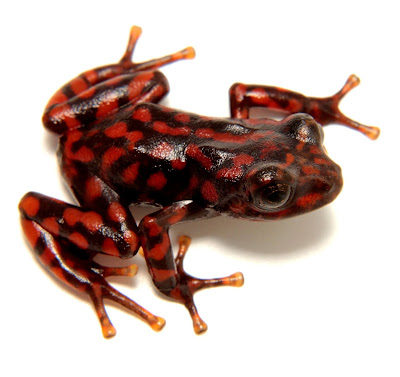[Most Recent Entries] [Calendar View]
Tuesday, January 12th, 2021
| Time | Event | ||||
| 2:03a | [Arachnida • 2020] On Sahastata (Araneae: Filistatidae): Complementary Description of the Generotype and Two New Species from Oman and Morocco
Abstract The Filistatinae genus Sahastata Benoit, 1968 is distributed in arid and semi-arid areas, from westernmost Sahara to India, and includes seven known species. Four of these are only known from one sex, including Sahastata nigra (Simon, 1897), the type species. Here we present the first description of a male of this species collected near the type locality in Muscat, Oman. Additionally, two new species are described: S. wunderlichi sp. nov. (♂♀, Morocco) and S. wesolowskae sp. nov. (♂♀, Oman). Sahastata infuscata (Kulczyński, 1901) is newly recorded from Kenya and Yemen and S. nigra is newly recorded from the United Arab Emirates. DNA barcodes are given for S. nigra and the two new species. We observed some details of the life cycle of three Sahastata species, including clutch size, time to maturation, and a biased sex ratio for individuals raised from egg sacs, indicating that only 20–25% of specimens reaching adulthood are males. We provide SEM images of spiders of this genus, some observations on the morphology of spinnerets and male palps, and a distribution map of the species included in the genus. Keywords: Araneae, Arabia, barcode, desert, Filistatinae, Maghreb, Sahara, spider, taxonomy Ivan L. F. Magalhaes, Mark Stockmann, Yuri M. Marusik and Sergei L. Zonstein. 2020. On Sahastata (Araneae: Filistatidae): Complementary Description of the Generotype and Two New Species from Oman and Morocco. Zootaxa. 4899(1); 215–246. DOI: 10.11646/zootaxa.4899.1.12 | ||||
| 2:05a | [Crustacea • 2020] Caridina sinanensis • A New Species of Stygobiotic Atyid Shrimp (Decapoda, Caridea, Atyidae) from A Karst Cave in the Guizhou Province, southwestern China
Abstract From a biodiversity survey of a subterranean habitat near Sinan County, Guizhou Province, southwestern China, a new atyid shrimp of the genus Caridina H. Milne Edwards, 1837, C. sinanensis sp. nov. was discovered. The new species can be separated from other congeners based on a combination of characters including depigmentation in body and reduction of eyes, small pigment spot at the centre of the cornea, the shape of rostrum and the endopod of the 1st male pleopod, and the relatively longer appendix interna on the appendix masculina of the 2nd pleopod. Mitochondrial COI and 16S rRNA gene sequences also support the establishment of the new species. Information on the habitat, and the levels of threat are discussed to guide the conservation of C. sinanensis sp. nov. Keywords: Caridina, COI and 16S rRNA, freshwater biodiversity, karst landform, southwestern China, spelaeology, taxonomy
Family Atyidae De Haan, 1849 Genus Caridina H. Milne Edwards, 1837 Caridina sinanensis sp. nov. Diagnosis: Rostrum short, slightly sloping downwards, usually reaching to the end of the 2nd segment, occasionally reaching to the end of the 1st segment or the end of the 3rd segment of antennular peduncle, rostral formula 4–10+10–16/3–11. 1st pereiopod carpus 0.77–0.83× as long as chela, 1.6–1.7× as long as high; chela 1.9–2.2× as long as broad; fingers 1.2–1.3× as long as palm. 2nd pereiopod carpus 1.2–1.3× as long as chela, 4.7–6.1× as long as high; chela 2.2–2.9× as long as broad; fingers 1.6–2.3× as long as palm. 3rd pereiopod propodus 3.8–4.1× as long as dactylus, with 9–11 thin spines on the posterior and lateral margins. 5th pereiopod propodus 3.7–4.1 × as long as dactylus, with 11–13 thin spines on the posterior and lateral margins, dactylus terminating in one claw, with 38–44 spinules on flexor margin. Endopod of male 1st pleopod extending to 0.45–0.50× exopod length, distal half usually curved posteriorly in the natural, occasionally not bent backwards, wider proximally, subrectangular, 2.4–2.7× as long as wide, appendix interna well developed, arising from distal 1/3 of endopod, reaching beyond end of endopod. Appendix masculina of male 2nd pleopod rod-shaped, reaching to 0.51 length of endopod, appendix interna reaching to 0.93 length of appendix masculina. Uropodal diaeresis with 10–12 movable spinules. Eggs size (without eyespots) 0.67–0.82 × 1.29–1.38 mm, eggs size (containing embryos with eyes) 0.98–1.02 × 1.16–1.47 mm. Etymology: Caridina sinanensis is named after Sinan County, where the type locality is located. Da-Jian Xu, Deng-Xu Li, Xiao-Zhuang Zheng and Zhao-Liang Guo. 2020. Caridina sinanensis, A New Species of Stygobiotic Atyid Shrimp (Decapoda, Caridea, Atyidae) from A Karst Cave in the Guizhou Province, southwestern China. ZooKeys. 1008: 17-35. DOI: 10.3897/zookeys.1008.54190 | ||||
| 4:22a | [Cnidaria • 2017] Zoantharians (Hexacorallia: Zoantharia) Associated with Cold-Water Corals in the Azores Region: New Species and Associations in the Deep Sea Zoantharians are a group of cnidarians that are often found in association with marine invertebrates, including corals, in shallow and deep-sea environments. However, little is known about deep-sea zoantharian taxonomy, specificity and nature of their associations with their coral hosts. In this study, analyses of molecular data (mtDNA COI, 16S, and 12S rDNA) coupled with ecological and morphological characteristics were used to examine zoantharian specimens associated with cold-water corals (CWC) at depths between 110 and 800 m from seamounts and island slopes in the Azores region. The zoantharians examined were found living in association with stylasterids, antipatharians and octocorals. From the collected specimens, four new species were identified: (1) Epizoanthus martinsae sp. n. associated with the antipatharian Leiopathes sp.; (2) Parazoanthus aliceae sp. n. associated with the stylasterid Errina dabneyi (Pourtalès, 1871); (3) Zibrowius alberti sp. n. associated with octocorals of the family Primnoidae [Paracalyptrophora josephinae (Lindström, 1877)] and the family Plexauridae (Dentomuricea aff. meteor Grasshoff, 1977); (4) Hurlizoanthus hirondelleae sp. n. associated with the primnoid octocoral Candidella imbricata (Johnson, 1862). In addition, based on newly collected material, morphological and molecular data and phylogenic reconstruction, the zoantharian Isozoanthus primnoidus Carreiro-Silva, Braga-Henriques, Sampaio, de Matos, Porteiro & Ocaña, 2011, associated with the primnoid octocoral Callogorgia verticillata (Pallas, 1766), was reclassified as Zibrowius primnoidus comb. nov. The zoantharians, Z. primnoidus comb. nov., Z. alberti sp. n., and H. hirondelleae sp. n. associated with octocorals showed evidence of a parasitic relationship, where the zoantharian progressively eliminates gorgonian tissue and uses the gorgonian axis for structure and support, and coral sclerites for protection. In contrast, the zoantharian P. aliceae sp. n. associated with the stylasterid E. dabneyi and the zoantharian E. martinsae sp. n. associated with the antipatharian Leiopathes sp., appear to use the coral host only as support with no visible damage to the host. The monophyly of octocoral-associated zoantharians suggests that substrate specificity is tightly linked to the evolution of zoantharians. Keywords: antipatharians, gorgonians, molecular taxonomy, parasitic, phylogeny, stylasterids, Zoantharia Systematics Phylum Cnidaria Hatschek, 1888 Class Anthozoa Ehrenberg, 1831 Subclass Hexacorallia Haeckel, 1896 Order Zoantharia Gray, 1832 Suborder Macrocnemina Haddon and Shackleton, 1891 Family Parazoanthidae Delage and Hérouard, 1901 Genus Zibrowius Sinniger, Ocaña & Baco, 2013 Zibrowius primnoidus comb. nov. Zibrowius alberti sp. n. Etymology: This species name is dedicated to Prince Albert I of Monaco for his promotion of the oceanographic sciences in the late 19th to early 20th centuries, and for his oceanographic campaigns in the Azores which contributed to the increased knowledge of CWCs and associated fauna in the region. Genus Hurlizoanthus Sinniger, Ocaña & Baco, 2013 Hurlizoanthus hirondelleae sp. n. EtymologyThis species name is dedicated to the research yacht Hirondelle used by Prince Albert I of Monaco during his oceanographic campaigns in the Azores. Genus Parazoanthus Haddon and Shackleton, 1891 Parazoanthus aliceae sp.n. EtymologyThis species name is dedicated to another research yacht of Prince Albert I of Monaco, Princess Alice, used during his oceanographic campaigns in the Azores, and during which the homonymous seamount was discovered. Family Epizoanthidae Delage and Hérouard, 1901 Genus Epizoanthus Gray, 1867 Epizoanthus martinsae sp. n. Etymology The name of this species is dedicated to Dr. Helen Martins, researcher at the Department of Oceanography and Fisheries of the University of the Azores for her contribution to the advancement of marine science in the Azores through her research and dedication to the Azorean scientific journal Arquipélago. Marina Carreiro-Silva, Oscar Ocaña, David Stanković, Íris Sampaio, Filipe M. Porteiro\, Marie-Claire Fabri and Sergio Stefanni. 2017. Zoantharians (Hexacorallia: Zoantharia) Associated with Cold-Water Corals in the Azores Region: New Species and Associations in the Deep Sea. Front. Mar. Sci. 4:88. DOI: 10.3389/fmars.2017.00088 | ||||
| 11:20a | [Herpetology • 2020] Pristimantis andinodiabolus • A Fantastic New Species from the Pristimantis orcesi Group (Anura: Craugastoridae) from the southern Andes of Ecuador ABSTRACT We describe a new glandular terrestrial frog of the Pristimantis (Anura: Craugastoridae) genus. The new species inhabits the high montane forests of the Cañar province in southern Ecuador. It differs from other terrestrial frogs by having a striking dark gray and red dorsal coloration, dorsal skin with a corrugated texture, a small tubercle on the eyelid and heel, absence of vomerine odontophores, and large glandular patches on the supratympanic area, arms and limbs. Our molecular analyses show that the new species is in a clade with P. orcesi and P. erythros. Based on our results, we redefine the orcesi group and suggest that it contains only three species (P. orcesi, P. erythros, and the new species); the group is diagnosed mainly by exhibiting conspicuous dermal macroglands on the head, body and legs. KEYWORDS: Montane forest, subparamo, macroglands, taxonomy, systematics Pristimantis andinodiabolus sp. nov. Nombre común en español: Cutín diablo andino Common name in English: Andean Devil Rainfrog Etimología: El epíteto específico andinodiabolus proviene de la combinación de dos palabras, “andino” que hace referencia a los Andes, palabra de origen quechua y “diabolus” en griego, que significa diablo o demonio y hace alusión a su combinación de colores rojo brillante con gris oscuro, única entre todas las especies del género en los Andes de Ecuador. Etymology: The specific epithet andinodiabolus comes from the combination of two words, "Andean" which refers to the Andes, a word of Quechua origin, and "diabolus" in Greek, which means devil or demon and refers to its combination of bright red and gray colors. dark, unique among all species of the genus in the Andes of Ecuador. Juan C. Sánchez-Nivicela, Verónica L. Urgiles, Jhonny Cedeño-Palacios, Homero Abad-Peñafiel and Juan M. Guayasamin. 2020. A Fantastic New Species from the Pristimantis orcesi group from the southern Andes of Ecuador [Una fantástica nueva especie del grupo Pristimantis orcesi de los Andes sur de Ecuador]. Neotropical Biodiversity. 6(1); 224-237. DOI: 10.1080/23766808.2020.1869449 RESUMEN: Describimos una nueva rana terrestre glandular del género Pristimantis (Anura: Craugastoridae), que habita en el bosque montano alto de la provincia del Cañar en el sur del Ecuador. La nueva especie se diferencia de otras ranas terrestres de los altos Andes por su llamativa coloración dorsal gris oscuro y rojo, piel del dorso con una textura corrugada, un diminuto tubérculo en el párpado y talón, ausencia de odontóforos vomerinos, y grandes parches glandulares en la zona supratimpánica, flancos y extremidades. Los análisis moleculares muestran que la nueva especie conforma un clado con P. orcesi y P. erythros. Con base en nuestros análisis, redefinimos el grupo orcesi, el cual contiene únicamente tres especies (P. orcesi, P. erythros y la nueva especie); el grupo se caracteriza por la presencia de macroglándulas cutáneas en la cabeza, cuerpo y extremidades. PALABRAS CLAVE: Bosque montano, subpáramo, macroglándulas, taxonomía, sistemática |
| << Previous Day |
2021/01/12 [Calendar] |
Next Day >> |





















